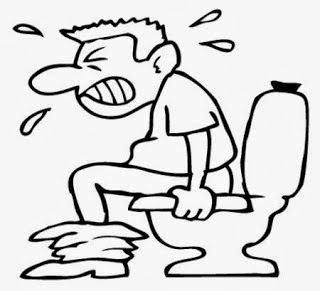Nursing Diagnosis and Interventions for Constipation
Constipation is a little defecation frequency, stool is not sufficient in number, in the form of hard and dry (Oenzil, 1995).
Constipation is a decrease in frequency of defecation, stool followed by spending long or hard and dry. There was an effort straining during defecation is a sign associated with constipation. If the small intestine motility slowed, a longer period of exposure to feces on the intestinal wall and most of the absorbed water content in the feces. A small amount of water left out to soften and lubricate the stool. Spending dry and hard stools can cause pain in the rectum. (Potter & Perry, 2005).
1. Constipation related to irregular defecation pattern
Goal : Patients can defecate regularly (every day)
Outcomes:
Independent:
1. Determine the pattern of defecation and trained to do so.
Rationale: To restore the regularity of defecation pattern.
2. Set the right time for defecation, such as after meals.
Rationale: To facilitate defecation reflex.
3. Provide coverage in accordance with the indications of nutritional fiber.
Rationale: Nutrition high fiber to launch fecal elimination.
4. Give fluids if not contraindicated 2-3 liters per day.
Rationale: To soften the stool elimination.
Collaboration:
5. Provision of laxatives or enemas as indicated.
Rationale: To soften the stool.
2. Imbalanced Nutrition, Less Than Body Requirements related to loss of appetite
Goal: demonstrate good nutritional status
Outcomes:
Independent :
1. Make meal planning to put in a feeding schedule.
Rationale : Keeping the patient's diet, so patients eat regularly.
2. Support family members to bring favorite foods from the patient's home.
Rationale : The patient feels comfortable with food brought from home and can improve the patient's appetite.
3. Offer large meals during the day when the high appetite.
Rationale : By giving a large portion can maintain adequacy of nutrient intake.
4. Ensure that the diet meets the needs of the body as indicated.
Rationale : High carbohydrate, protein, and calories needed or required for treatment.
5. Make sure that the patient's diet is liked or disliked.
Rationale : To support the improvement of the patient's appetite.
6. Monitor input and expenditure and body weight periodically.
Rationale : Knowing the balance of food intake and output.
7. Assess the patient's skin turgor.
Rationale : As the data supporting a change in nutrition less than the requirement.
Collaboration:
8. Monitor laboratory values, such as hemoglobin, albumin, and blood glucose levels.
Rationale: In order to determine the level of Hb content deficiencies, albumin, and glucose in the blood.
9. Teach method for meal planning.
Rationale: Clients are accustomed to eating in a planned and orderly.
10. Health Education: Teach patients and families about nutritious food and not expensive.
Rational: Maintain the required nutrition adequacy.
Constipation is a decrease in frequency of defecation, stool followed by spending long or hard and dry. There was an effort straining during defecation is a sign associated with constipation. If the small intestine motility slowed, a longer period of exposure to feces on the intestinal wall and most of the absorbed water content in the feces. A small amount of water left out to soften and lubricate the stool. Spending dry and hard stools can cause pain in the rectum. (Potter & Perry, 2005).
1. Constipation related to irregular defecation pattern
Goal : Patients can defecate regularly (every day)
Outcomes:
- Defecation can be done once a day.
- Soft stool consistency.
- Faecal elimination without excessive straining.
Independent:
1. Determine the pattern of defecation and trained to do so.
Rationale: To restore the regularity of defecation pattern.
2. Set the right time for defecation, such as after meals.
Rationale: To facilitate defecation reflex.
3. Provide coverage in accordance with the indications of nutritional fiber.
Rationale: Nutrition high fiber to launch fecal elimination.
4. Give fluids if not contraindicated 2-3 liters per day.
Rationale: To soften the stool elimination.
Collaboration:
5. Provision of laxatives or enemas as indicated.
Rationale: To soften the stool.
2. Imbalanced Nutrition, Less Than Body Requirements related to loss of appetite
Goal: demonstrate good nutritional status
Outcomes:
- Tolerance to dietary needs.
- Maintain body mass and body weight in the normal range.
- Laboratory values within normal limits.
- Reported adequacy of energy levels.
Independent :
1. Make meal planning to put in a feeding schedule.
Rationale : Keeping the patient's diet, so patients eat regularly.
2. Support family members to bring favorite foods from the patient's home.
Rationale : The patient feels comfortable with food brought from home and can improve the patient's appetite.
3. Offer large meals during the day when the high appetite.
Rationale : By giving a large portion can maintain adequacy of nutrient intake.
4. Ensure that the diet meets the needs of the body as indicated.
Rationale : High carbohydrate, protein, and calories needed or required for treatment.
5. Make sure that the patient's diet is liked or disliked.
Rationale : To support the improvement of the patient's appetite.
6. Monitor input and expenditure and body weight periodically.
Rationale : Knowing the balance of food intake and output.
7. Assess the patient's skin turgor.
Rationale : As the data supporting a change in nutrition less than the requirement.
Collaboration:
8. Monitor laboratory values, such as hemoglobin, albumin, and blood glucose levels.
Rationale: In order to determine the level of Hb content deficiencies, albumin, and glucose in the blood.
9. Teach method for meal planning.
Rationale: Clients are accustomed to eating in a planned and orderly.
10. Health Education: Teach patients and families about nutritious food and not expensive.
Rational: Maintain the required nutrition adequacy.

Komentar
Posting Komentar